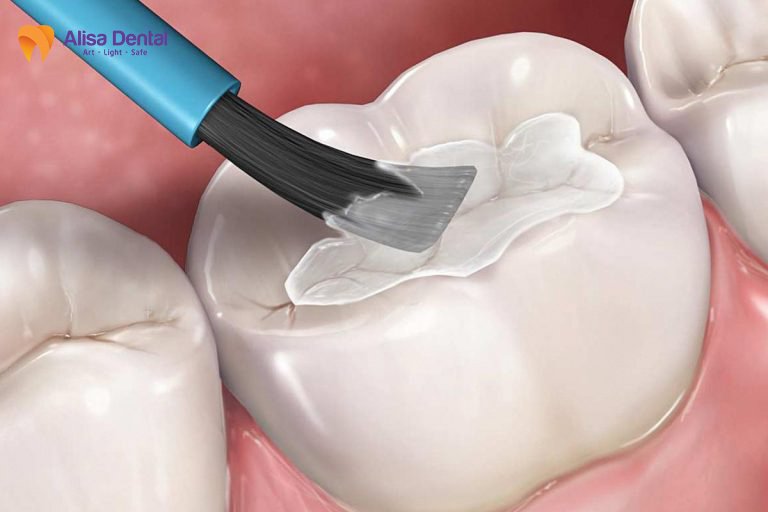Filling is a useful method in treating many dental problems such as cavities, gaps, and improving aesthetics to give you a perfect smile. Although this is a simple technique, many Vietnamese and foreign people wonder about the timing and process of fillings.
What is “fillings”?
Fillings, also known as tooth restoration – a dental technique using artificial materials to supplement missing tooth structure. Not only does this method enhance aesthetics, but it also helps improve chewing function.

Before and after images of dental fillings
Filling deep cavities
Tooth decay is usually a tooth with a cavity, caused by long-term accumulation of bacteria but not properly cared for. This leads to the cavity gradually enlarging, causing severe toothache, followed by infection and tooth fracture. To identify tooth decay, you can observe the following signs:
+ Sudden toothache
+ Tooth with a cavity
+ Tooth sensitivity
+ Surface of the tooth changes to brown, black, or white
+ Toothache after consuming sweet or cold drinks
+ Effective cosmetic tooth filling at Alisa dental clinic
Filling deep cavities will help fill the cavity and eliminate discomfort, restoring the aesthetics of the tooth. There are also different types of deep tooth fillings, depending on the current condition of the tooth.
Filling front teeth
Usually, the cuspid teeth are prone to gapping, affecting aesthetics. Therefore, filling the cuspid teeth gap is a commonly chosen method, but only applicable when the gap is small, around 2mm.
In cases of large gaps, the cuspid teeth will lose balance, so after filling the teeth, you will be advised by the dentist to switch to other techniques such as porcelain veneers or braces.
Filling gapped teeth or cuspid teeth can last from 4 to 8 years, but should be replaced at least every 3 years and up to 10 years depending on the position of the joint, bite alignment, or your eating habits.
Common materials used for dental fillings
Amalgam: also known as silver filling, is a long-standing and low-cost dental technique. The components of Amalgam include silver, tin, mercury, zinc, and copper. In terms of advantages, this material is very durable, can withstand chewing forces well, and is also inexpensive. However, because it has a silver color, the filling area will be easily noticeable, losing its natural appearance.
Composite: high aesthetic value and also favored by many people. The advantages of this type are that it has a color close to natural teeth, so it can be used for fillings in visible areas. However, composite fillings are usually not as durable as Amalgam, with an average lifespan of 5 years, 5-10 years less than Amalgam.
Porcelain: this is also a popular technique, suitable for cases with large fractures and requiring more complex techniques. The main advantage is that porcelain material has a color similar to natural teeth, is resistant to staining, and has better resistance to erosion than composite. The lifespan of this method is quite long, up to 10 years. The only drawback is that it is more expensive than Amalgam and Composite.
Gold: filling with gold or some other metals such as silver-copper will increase the hardness of the filling. Gold can withstand large chewing forces and has the best durability. Gold is also luxurious and will be less prone to wear compared to other materials. The drawback when choosing this material is that gold is more expensive and requires two visits to the dentist to perform this filling method.
The procedure for dental fillings at Alisa Dental Clinic
Currently, there are 2 common types of dental fillings, which are direct and indirect dental fillings.
Direct dental filling: the dentist will apply the filling material directly to the area of the tooth that needs restoration and shape it aesthetically according to the customer’s request.
Indirect dental filling: this technique is more complex, as it is attached outside the tooth structure, requiring both time and relatively high implementation costs. However, the durability of the filling piece cast using this method will be maintained for a very long time.
Specifically about the direct dental filling process:
Examination and consultation: The dentist will examine the tooth that needs filling, determine the size, and provide specific advice on the material to be used for the filling.
Then, the dentist will proceed to administer local anesthesia to ensure the patient’s comfort during the procedure.
Perform the dental filling: Pour the filling material into the deep cavity. Initially, the filling material is in liquid form, and after being exposed to laser, it gradually hardens in about 40 seconds through a photo-polymerization reaction.
Adjust the filling area: The dentist adjusts the filling, removes excess filling material, and then smoothes and polishes it to complete the process.
What is the procedure for filling deep cavities and indirect gaps between teeth?
The process of filling cavities, gaps, and indirect teeth is called inlay – onlay filling, helping to reduce the gap between the filling and the tooth tissue. Similar to direct fillings, the dentist will conduct an examination, provide advice, and administer anesthesia. The difference lies in the dentist taking an impression of the tooth arch and making the filling externally. After the filling is crafted, it will be attached snugly to the tooth using specialized cement.
This process usually takes about 30 – 45 minutes and requires approximately two appointments with the dentist.

The procedure for dental fillings at Alisa
Important notes when getting dental fillings
Before going to get a dental filling, many people will wonder if getting a dental filling hurts. The answer is no, and in many cases, getting a dental filling can even be very quick. However, this is not absolute because depending on the individual’s body, health, and the condition of the teeth, the pain sensation will vary.
For cases with severe tooth decay or inflamed pulp, before filling, the dentist will remove the pulp so you may feel quite numb.
Decayed pulp can cause many problems for oral health.
In the first two hours after getting a dental filling, you should not eat to limit the movement of the filling material and to allow better adaptation to the teeth. You should also avoid sticky, hard, and tough foods for 2 days, especially if you choose silver fillings. If your teeth feel numb, you should limit the consumption of very hot or very cold food and drinks.
To protect the filling area best, you should avoid biting too hard or grinding your teeth as it can create pressure on the teeth, making the filling area prone to chipping.
When cleaning the filling area, you should choose soft-bristled toothbrushes to avoid erosion. When eating, especially sugary foods, you should rinse your mouth immediately. Every 6 months, you should visit reputable dental clinics for check-ups.
One of the reputable dental clinics in Hanoi where you can consider for your perfect smile is Alisa. With a team of professional consultants and technicians, you will not only receive examinations and advice but also be cared for attentively from the examination to completion. Choosing a reputable dental clinic is very important, helping you maintain the quality of the filling area, feel more assured during procedures, and receive support throughout the treatment process.


